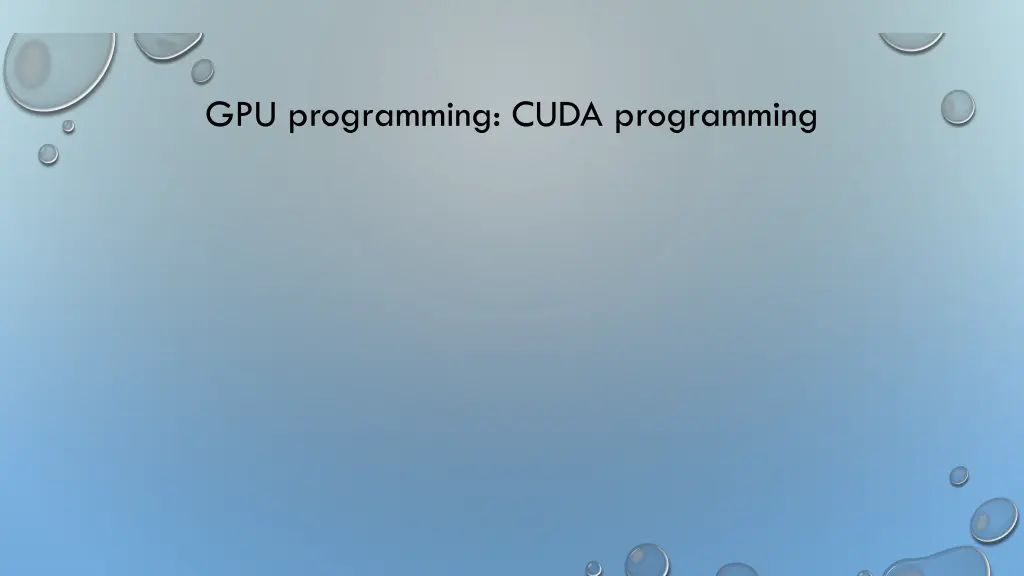
Understanding CUDA Programming for GPU Acceleration
Explore the world of GPU programming with CUDA, NVIDIA's parallel computing model. Learn about heterogeneous programming, CUDA kernels, memory management, and the basic structure of CUDA programs. Dive into allocating memory in the GPU and host, and discover the fork-join model for parallel processing.
Uploaded on | 2 Views
Download Presentation

Please find below an Image/Link to download the presentation.
The content on the website is provided AS IS for your information and personal use only. It may not be sold, licensed, or shared on other websites without obtaining consent from the author. If you encounter any issues during the download, it is possible that the publisher has removed the file from their server.
You are allowed to download the files provided on this website for personal or commercial use, subject to the condition that they are used lawfully. All files are the property of their respective owners.
The content on the website is provided AS IS for your information and personal use only. It may not be sold, licensed, or shared on other websites without obtaining consent from the author.
E N D
Presentation Transcript
Compute Unified Device Architecture(CUDA) CUDA is Nvidia s scalable parallel programming model and a software environment for parallel computing that allows the use of GPU for general purpose processing. oLanguage: CUDA C, minor extension to C/C++ Let the programmer focus on parallel algorithms not parallel programming mechanisms. oA heterogeneous serial-parallel programming model Designed to program heterogeneous CPU+GPU systems CPU and GPU are separate devices with separate memory
Heterogeneous programming with CUDA Fork-join model: CUDA program = serial code + parallel kernels (all in CUDA C) Serial C code executes in a host thread (CPU thread) Parallel kernel code executes in many device threads (GPU threads)
CUDA kernel Kernel code is regular C code except that it will use thread ID (CUDA built-in variable) to make different threads operate on different data oAlso have variables for the total number of threads When a kernel is reached in the code for the first time, it is launched onto GPU.
CPU and GPU memory CPU and GPU have different memories: CPU CPU memory is called host memory GPU memory is called device memory CPU main memory Copy from CPU to GPU Copy from GPU to CPU o Implication: Explicitly transfer data from CPU to GPU for GPU computation, and GPU global memory Explicitly transfer results in GPU memory copied back to CPU memory GPU
Basic CUDA program structure int main (int argc, char **argv ) { 1. Allocate memory space in device (GPU) for data 2. Allocate memory space in host (CPU) for data 3. Copy data to GPU 4. Call kernel routine to execute on GPU (with CUDA syntax that defines no of threads and their physical structure) 5. Transfer results from GPU to CPU 6. Free memory space in device (GPU) 7. Free memory space in host (CPU) return; }.
Allocating memory in GPU (device) The cudaMalloc routine: allocates object in the device global memory o Two parameters: address of a pointer to the allocated object size of the allocated object in terms of bytes. int size = N *sizeof( int); // space for N integers int *devA, *devB, *devC; // devA, devB, devC ptrs cudaMalloc( (void**)&devA, size) ); cudaMalloc( (void**)&devB, size ); cudaMalloc( (void**)&devC, size ); 2. Allocating memory in host (CPU)? o The regular malloc routine
Transferring data from/to host (CPU) to/from device (GPU) CUDA routine cudaMemcpy: memory data transfer o four parameters pointer to destination pointer to source number of bytes copied Type/direction of transfer cudaMemcpy( devA, &A, size, cudaMemcpyHostToDevice); cudaMemcpy( devB, &B, size, cudaMemcpyHostToDevice); DevA and devB are pointers to destination in device (return from cudaMalloc and A and B are pointers to host data
Defining and invoking kernel routine Define: CUDA specifier __global__ #define N 256 A kernel that can be called from the host. __global__ void vecAdd(int *A, int *B, int *C) { // Kernel definition int i = threadIdx.x; C[i] = A[i] + B[i]; } threadIdx is a built-in variable Each thread performs one pair-wise addition: Thread 0: devC[0] = devA[0] + devB[0]; Thread 1: devC[1] = devA[1] + devB[1]; Thread 2: devC[2] = devA[2] + devB[2]; int main() { // allocate device memory & // copy data to device // device mem. ptrs devA,devB,devC vecAdd<<<1, N>>>(devA,devB,devC); } This is the fork-join statement in Cuda Notice the devA/B/C are device memory pointer
CUDA kernel invocation <<< >>> syntax (addition to C) for kernel calls: myKernel<<< n, m >>>(arg1, ); <<< >>> contains thread organization for this particular kernel call in two parameters, n and m: ovecAdd<<<1, N>>>(devA,devB,devC): 1 dimension block with N threads in the block. Threads execute very efficiently on GPU (much more efficiently than pthread or OpenMP threads): we can have fine-grain threads (a few statements) oMore thread organization later arg1, , -- arguments to routine myKernel typically pointers to device memory obtained previously from cudaMallac.
5. Transferring data from device (GPU) to host (CPU) Once the kernel returns, the results are in the GPU memory (dec_C in the example). CUDA routine cudaMemcpy cudaMemcpy( &C, dev_C, size, cudaMemcpyDeviceToHost); odev_C is a pointer in device memory and C is a pointer in host memory.
6. Free memory space receiver In device (GPU) -- Use CUDA cudaFree routine: cudaFree( dev_a); cudaFree( dev_b); cudaFree( dev_c); In (CPU) host (if CPU memory allocated with malloc) -- Use regular C free routine: free( a ); free( b ); free( c );
Complete CUDA examples See lect26/vecadd.cu Compiling CUDA programs oUse the aurora1.cs.fsu.edu and aurora2.cs.fsu.edu oNaming convention: .cu programs are CUDA programs oNVIDIA CUDA compiler driver: nvcc oTo compile vecadd.cu: nvcc O3 vecadd.cu
Compilation process nvcc wrapper divides code into host and device parts. Host part compiled by regular C compiler Device part compiled by NVCC s runtime component Two compiled parts combined into one executable
